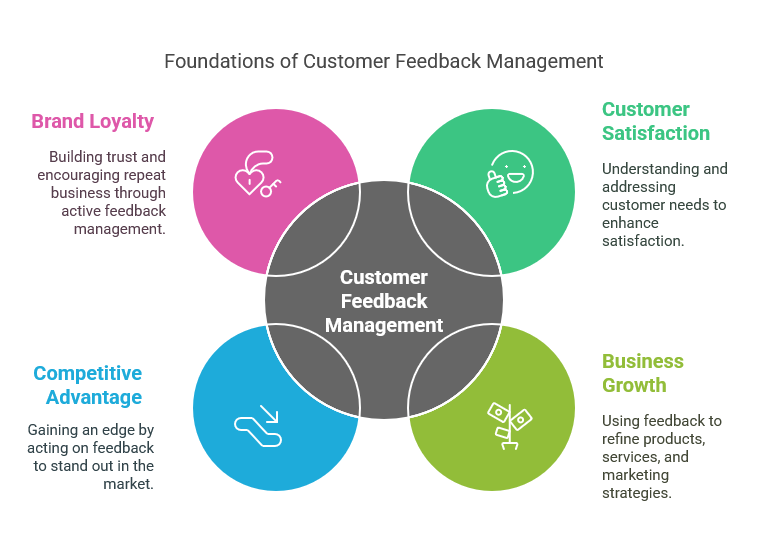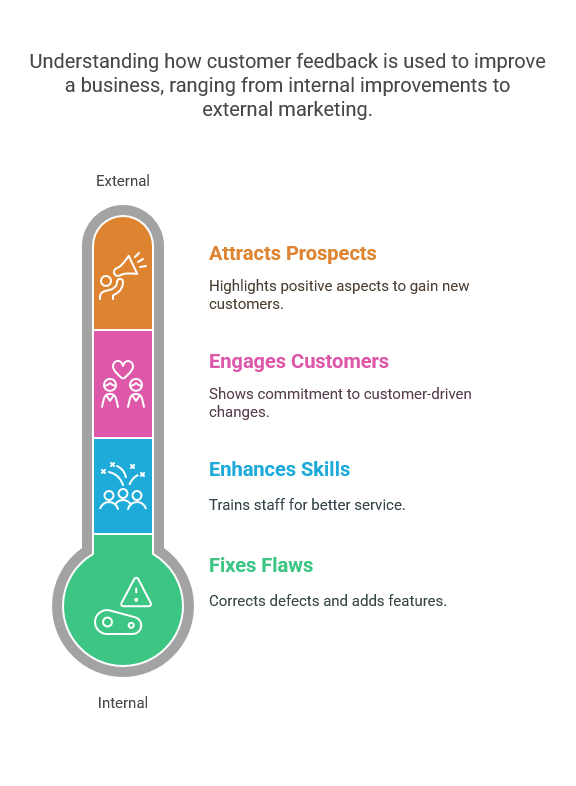Customer feedback management refers to the process of collecting, analyzing, and acting on feedback provided by your customers. Feedback can come in many forms—surveys, reviews, complaints, or even social media comments. Managing this feedback means that you use it to understand your customers’ needs, identify areas for improvement, and optimize your business processes.
When managed well, feedback can act as a guide to creating a better experience for your customers. It can help you understand what you’re doing right and where there is room for growth.
Why Customer Feedback Management Matters
Managing customer feedback is vital for a number of reasons. Here are some of the most important:
-
Customer Satisfaction: Without understanding customer needs and expectations, businesses can’t deliver the right services. Customer feedback helps to address pain points and improve satisfaction.
-
Business Growth: Feedback provides valuable insights into what your customers like or dislike about your business. These insights help you refine products, services, and even marketing strategies.
-
Competitive Advantage: Listening to customer feedback can give you an edge over competitors. By acting on feedback, you can stand out in a crowded market and attract more customers.
-
Brand Loyalty: When customers see that their opinions matter, they are more likely to stick around. Loyalty is built on trust, and active feedback management builds that trust.
According to a Zendesk survey, 42% of customers expect a company to respond to feedback within 24 hours. This shows how important it is to be prompt and responsive.

Key Benefits of Managing Customer Feedback
-
Improves Customer Satisfaction
When customers know that their opinions are heard, they feel more valued. This leads to increased satisfaction and trust. -
Helps Retain Customers
It’s much more expensive to acquire new customers than to keep existing ones. By actively managing feedback, you can retain customers who feel their needs are being addressed. -
Drives Product Improvements
Feedback provides insights into what aspects of your product or service need improvement. This can guide future product development and service refinement. -
Enhances Brand Image
When customers see you take their feedback seriously and act on it, your brand image improves. This boosts your reputation, both online and offline. -
Increases Revenue
Satisfied customers are more likely to return and recommend your business to others. Positive word-of-mouth and repeat purchases are a direct result of effective feedback management.
How to Collect Customer Feedback Effectively
Collecting customer feedback is the first step in feedback management. But collecting it effectively is just as important. Here’s how you can do that:
-
Surveys:
Create short, targeted surveys after customer interactions. Make the questions clear and simple. Keep it concise to encourage responses. Tools like SurveyMonkey and Google Forms make it easy to design and distribute surveys. -
Online Reviews:
Monitor platforms where customers may leave reviews, such as Google, Yelp, and Trustpilot. Reviews provide honest, unfiltered opinions that can be incredibly useful. -
Social Media:
Your customers are likely to share their opinions on platforms like Facebook, Twitter, and Instagram. Monitor mentions of your business and track feedback via social media management tools. -
Customer Support:
After interacting with your support team, ask customers to share their experience. This helps you understand areas where your customer service can be improved.
Understanding Different Types of Feedback
Not all feedback is the same. Here are some different types of customer feedback:
-
Positive Feedback:
This is when customers share their satisfaction and appreciation. Positive feedback should be acknowledged and celebrated. You can use it to highlight what your business does well in marketing. -
Negative Feedback:
This feedback points out where your product or service is lacking. While difficult to hear, negative feedback is a valuable opportunity for improvement. Address it quickly and professionally to resolve customer issues. -
Constructive Feedback:
Customers who provide constructive feedback offer suggestions for improvement. This type of feedback is highly valuable because it gives you specific areas to work on. -
Actionable Feedback:
Actionable feedback is feedback that you can directly use to make improvements. This is the type of feedback that leads to real changes in your business practices.
Understanding these different types helps you take the right approach to each piece of feedback and address customer concerns accordingly.
Best Practices for Analyzing Customer Feedback
Once you’ve collected feedback, it’s time to analyze it. Here are some best practices for doing this effectively:
-
Look for Patterns:
Don’t just focus on individual comments. Look for common themes or issues that multiple customers raise. This will help you identify recurring problems or areas for improvement. -
Prioritize Issues:
Not all feedback is equally important. Focus on the issues that affect the majority of your customers. Addressing these will lead to the most significant improvements. -
Measure Sentiment:
By analyzing the tone of feedback, you can determine whether customers are generally happy or dissatisfied. Positive feedback can be used to reinforce your strengths, while negative feedback can highlight areas that need attention. -
Act on Feedback:
Feedback is only valuable if you act on it. Address the issues that customers raise, implement changes where necessary, and communicate with customers to let them know their feedback has been used.
How to Use Customer Feedback to Improve Your Business
Effective use of customer feedback can transform your business. Here’s how:
-
Improve Products and Services:
If feedback reveals recurring complaints, use this information to enhance your offerings. Whether it’s fixing product defects or adding new features, your customers will appreciate the improvements. -
Train Your Team:
Feedback can show areas where your staff need additional training. If customers mention slow response times or poor customer service, address these issues by training your team better. -
Refine Marketing Strategies:
Positive feedback can be used in your marketing campaigns to attract new customers. Highlight what people love about your product or service in your ads. -
Boost Customer Relationships:
Actively responding to feedback creates a sense of partnership with your customers. Let them know you’re listening and committed to making changes based on their input.

Tools to Help You Manage Customer Feedback
Several tools can help businesses collect, manage, and analyze customer feedback. Here are a few of the most popular:
-
SurveyMonkey:
A tool for creating and distributing surveys to gather feedback. -
Zendesk:
A customer service platform that helps you manage customer inquiries and feedback. -
Hootsuite:
A social media management tool that allows you to track feedback across platforms like Twitter, Facebook, and Instagram. -
Google Forms:
An easy-to-use tool for creating simple feedback forms. -
Freshdesk:
A customer support tool that also allows you to gather feedback from customers during and after support interactions. Official Website
Challenges in Customer Feedback Management
Despite its benefits, managing customer feedback can be challenging:
-
Low Response Rates:
It can be hard to get customers to fill out surveys or leave reviews. Offer incentives like discounts or loyalty points to encourage responses. -
Overwhelming Amount of Feedback:
As your business grows, the volume of feedback can become difficult to manage. Use tools to filter and prioritize feedback effectively. -
Handling Negative Feedback:
Not all feedback will be positive. Learning how to respond to negative feedback with professionalism and a focus on solutions is crucial.
Despite these challenges, properly managing customer feedback can lead to a more loyal customer base and continuous improvement in your business.
Frequently Asked Questions (FAQs)
1. What is customer feedback management?
It’s the process of gathering, analyzing, and responding to feedback from your customers to improve your business operations.
2. How can feedback help my business grow?
By acting on feedback, businesses can improve their products, services, and customer relationships, which leads to growth.
3. What are the best tools for managing customer feedback?
Tools like SurveyMonkey, Google Forms, Zendesk, and Hootsuite help businesses manage and respond to feedback.
4. Why is customer feedback important?
Customer feedback helps businesses identify strengths and weaknesses, improve their offerings, and boost customer satisfaction.
5. How do I analyze customer feedback effectively?
Look for patterns, prioritize issues, measure sentiment, and act on the feedback to make improvements.
Customer feedback management is essential for any business that wants to improve customer satisfaction, retain customers, and drive growth. By effectively gathering, analyzing, and responding to feedback, you can turn your customers’ insights into meaningful business improvements. Whether you’re a small business or a large corporation, implementing a strong feedback management system will ensure that your business stays in tune with customer needs and stays ahead of the competition.

